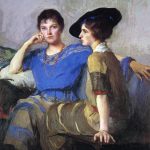
Olga Boznańska (1865–1940) was a Polish painter known for her portraits and genre scenes. She was born on April 15, 1865, in Kraków, Poland, which was then part of the Austro-Hungarian Empire.
Boznańska began her artistic education at the Kraków School of Fine Arts, where she studied under Jan Matejko, a prominent Polish historical painter. Later, she continued her studies in Munich, Germany, and then in Paris, France, where she was exposed to various artistic influences.

Her early works were influenced by Realism, but over time, she embraced a more modern and individualistic style. Boznańska was known for her ability to capture the psychological depth of her subjects, particularly in her portraits of women and children. Her portraiture often conveyed a sense of intimacy and sensitivity.

Boznańska gained recognition in the Parisian art scene, and her works were exhibited at the Salon de Paris. She became the first woman to be awarded the Legion of Honour in 1911, highlighting her significant achievements in the art world.

Throughout her career, Boznańska’s art evolved, and she incorporated elements of Symbolism and Art Nouveau into her work. Her paintings often featured a muted color palette and a focus on composition and emotional expression.
After World War I, Boznańska returned to Poland and continued to paint, becoming an influential figure in the Polish art scene. She received numerous awards and honors for her contributions to the arts.

Olga Boznańska passed away on October 26, 1940, in Paris. Her legacy endures through her impact on Polish art and her role as a pioneering woman artist in a male-dominated field. Her works can be found in various museums and collections, and she is remembered as one of the leading figures in Polish painting of the late 19th and early 20th centuries.






